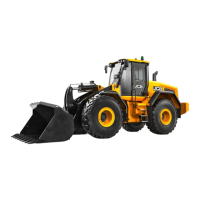
Do you have a question about the jcb 457 and is the answer not in the manual?
| Brand | jcb |
|---|---|
| Model | 457 |
| Category | Compact Loader |
| Language | English |
Importance of studying the operator's manual for safe operation and understanding machine functions.
Explanation of new machine operations and functions by a JCB Dealer Representative.
Information provided in the manual, model range, and how to use it for understanding the machine.
Definition of 'left' and 'right', and notes on cab/canopy references and cross-references.
General hazards of machinery, importance of reading and understanding warnings for safe operation.
Explanation of signal words (DANGER, WARNING, CAUTION, Notice) and the safety alert system symbol.
Requirement for operator skill, knowledge of laws, and constant alertness for hazards.
Guidelines on correct clothing, avoiding alcohol/drugs, and operating when feeling unwell.
Safety precautions for lifting equipment, raised machines, and prohibiting unauthorized modifications.
Safety advice regarding mobile phones in explosive atmospheres and lightning.
Guidelines on wearing protective clothing and personal safety equipment based on job conditions and regulations.
Guidance on understanding machine operation, controls, levers, switches, gauges, buttons, and pedals.
Details on the manufacturer and product compliance with laws and regulations.
General description of the machine's capabilities as a wheeled loader.
Machine's intended applications and safety requirements for hazardous environments.
Safety precautions for log handling and information on optional attachments.
Definition and importance of the danger zone for operator and bystander safety.
Identification of key machine components including ROPS/FOPS cab, Ram, Loader arms, Shovel, and Engine cover.
Information on the machine's identification plate, PIN, weight, engine power, year of manufacture, and serial number.
Location of the engine data plate and identification number on the crankcase.
Warnings about operating with damaged ROPS/FOPS, importance of seat belts, and modification restrictions.
Details on the machine's ROPS/FOPS data plate and its significance for safety standards.
Explanation of the two levels of Falling Object Protective Structure (FOPS) impact protection.
Importance of safety labels, their placement, and instructions for keeping them clean and readable.
Identification and description of various safety labels found on the machine, including their meaning and purpose.
Further details on specific safety labels, their part numbers, descriptions, and quantity.
Identification and location of various controls and components within the operator station.
Description of the 4-position ignition switch, its functions, and safe operating procedures.
Operation of the multi-purpose switch for direction indicators and windscreen wipers.
Operation of windscreen washer, horn, headlight flash, and main beam functions via the stalk switch.
Description of the three-position switch for the cab interior light and its functions.
Overview of console switches, their graphic symbols, and active function indicators.
Explanation of indicator lamps on buttons to show switch status (on/off).
Details on road light, headlight, beacon, and rear fog light switches and their operation.
Operation of work lamps, rear wash/wipe, and heated rear screen/mirrors.
Function of secondary steering, engine modes, and transmission auto mode.
Explanation of lockup, differential lock, ICCO, constant flow, fan reverse, and SRS.
Function of the detents switch for loader controller operation.